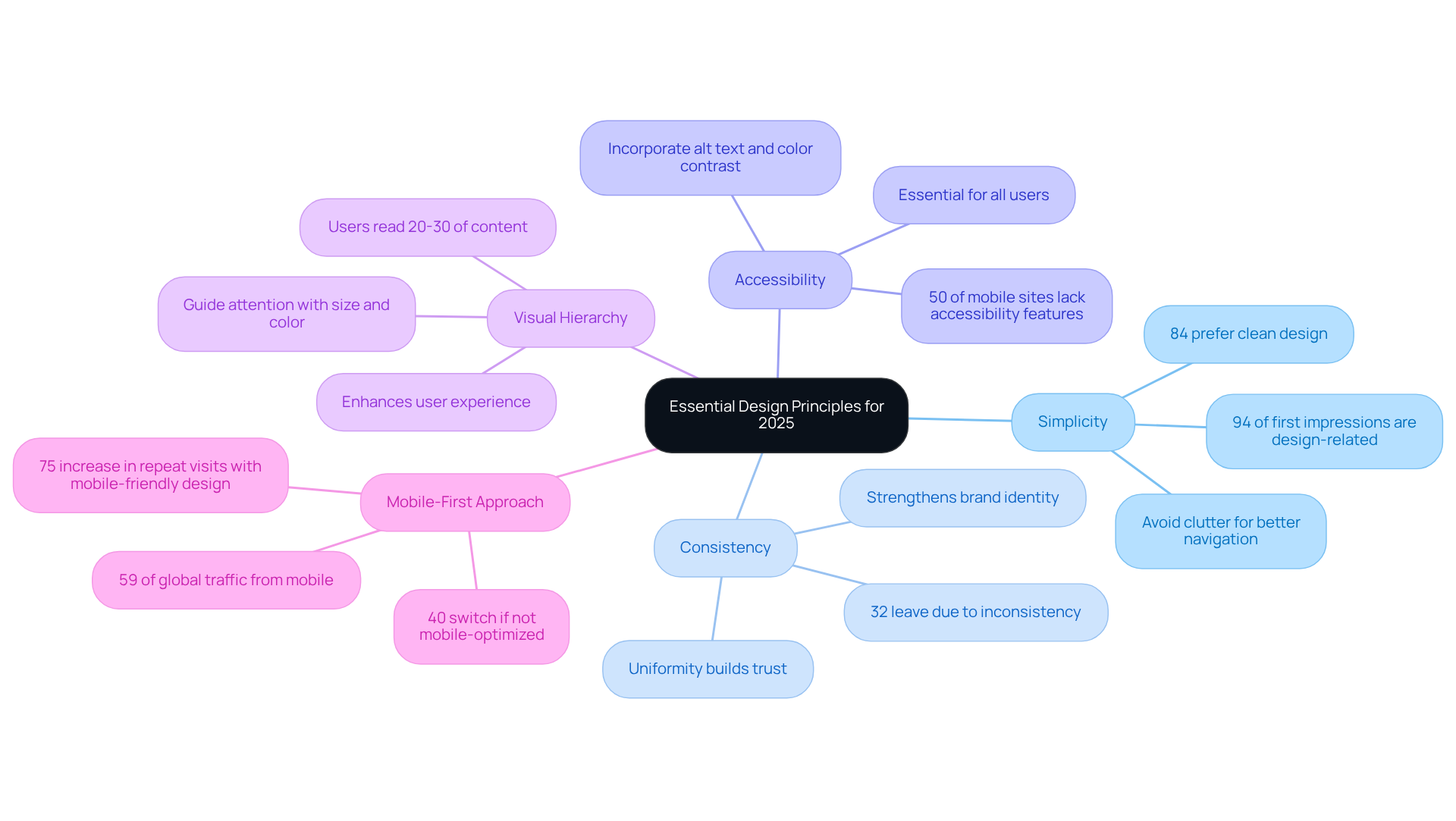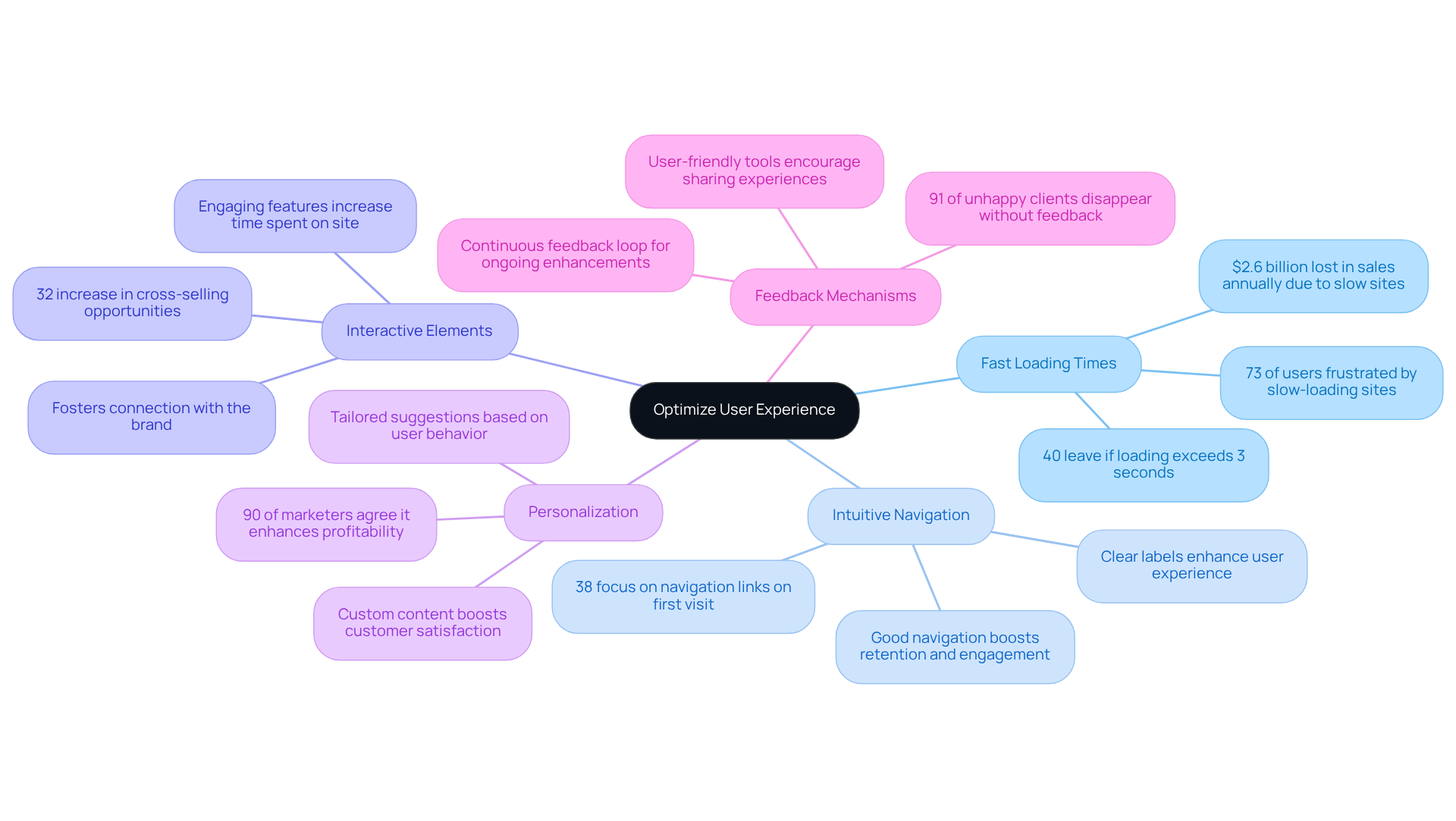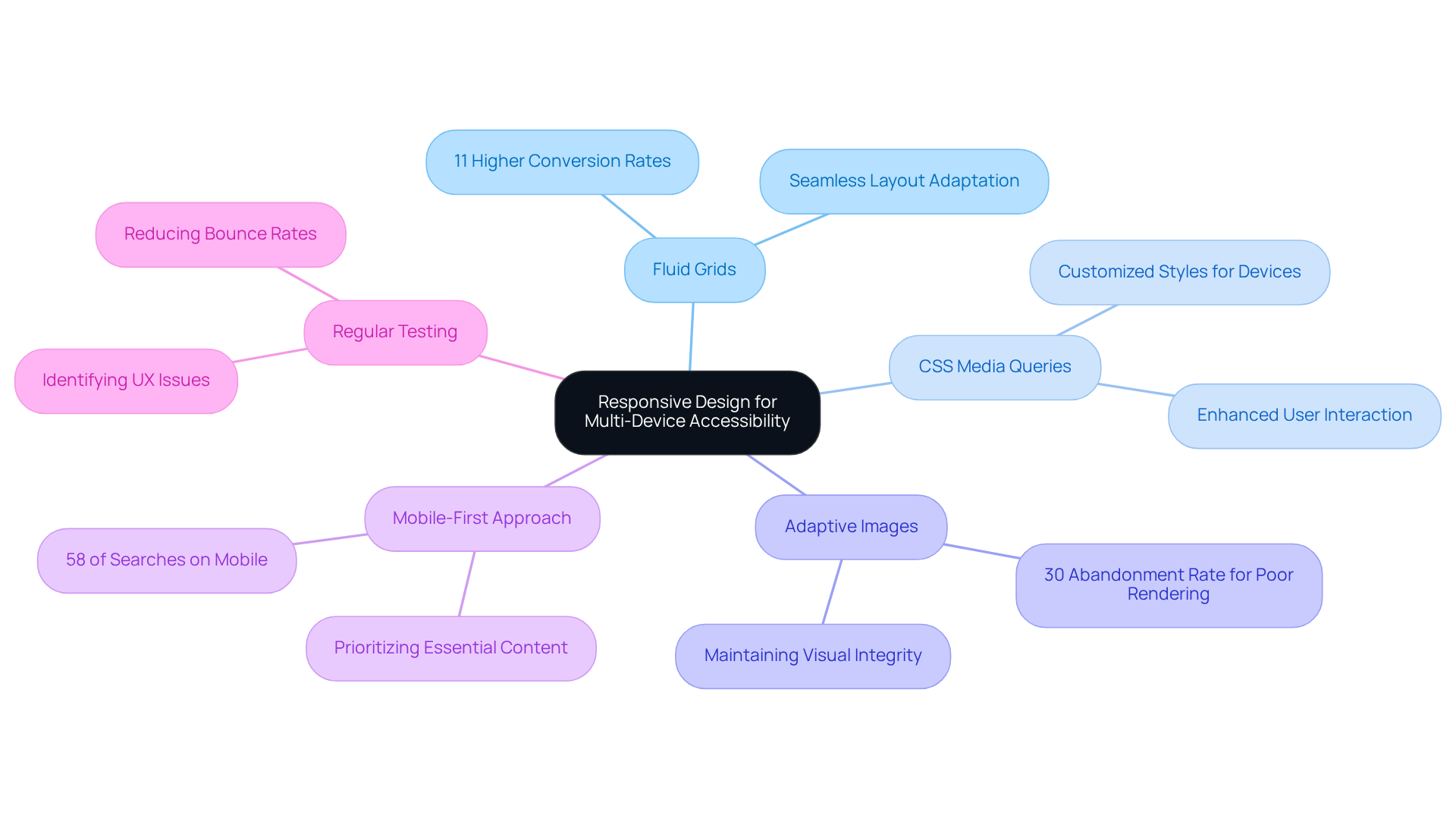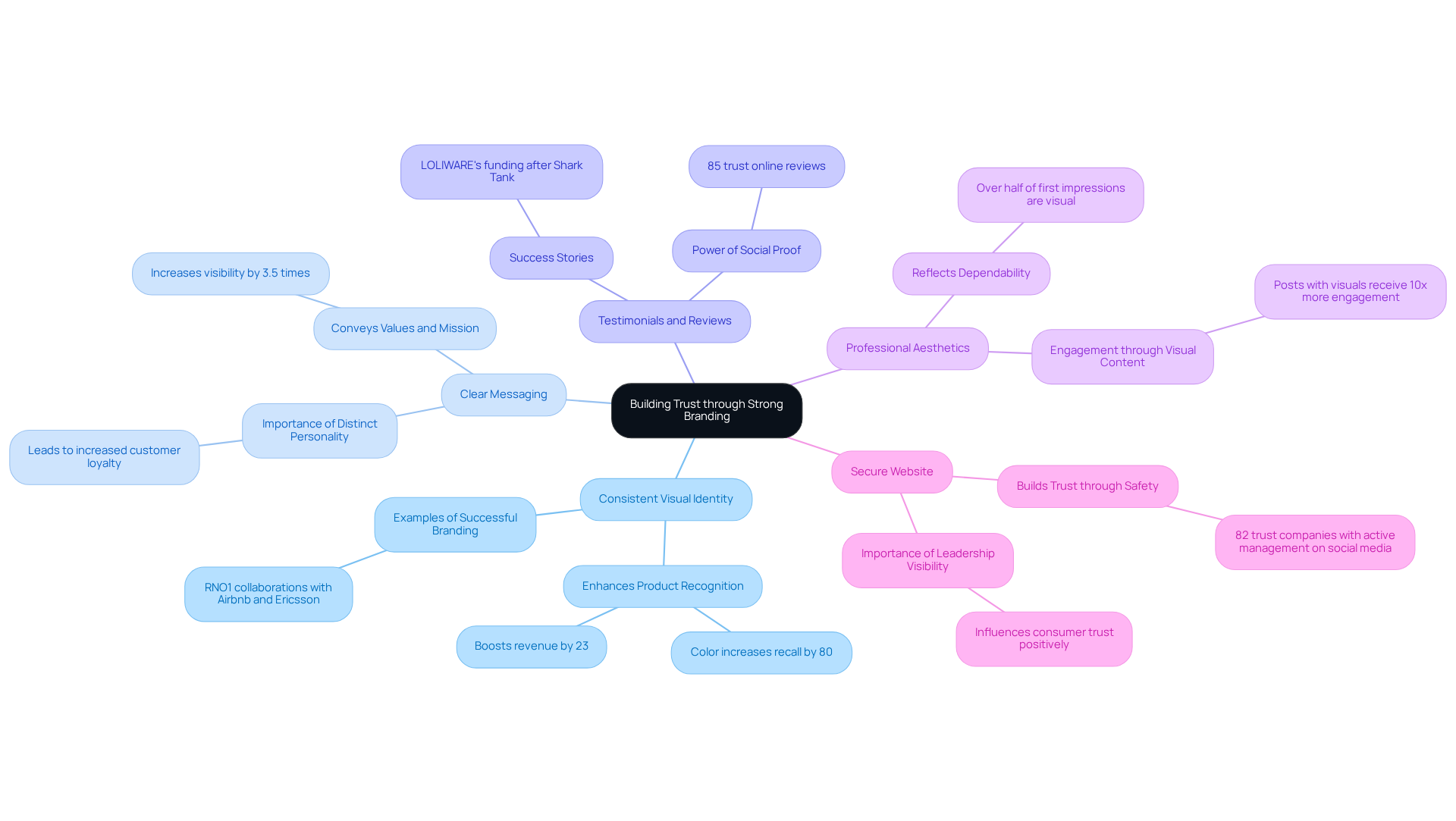Overview
In 2025, many tech startups face the challenge of creating websites that truly resonate with their audience. The problem often lies in the complexity of design, which can lead to frustration for users. This complexity not only hampers navigation but can also erode trust in your brand. As a startup founder, you want your users to feel welcomed and understood, and that’s where the right website design strategies come into play.
Embracing simplicity, consistency, accessibility, and a mobile-first approach can significantly enhance user experience and engagement. These principles are not just buzzwords; they are essential for nurturing a positive relationship with your audience. When your website is easy to navigate and visually appealing, it fosters trust and encourages users to explore further. This, in turn, can lead to higher conversion rates, which is crucial in today’s increasingly digital marketplace.
Imagine a potential customer landing on your website and feeling an immediate sense of ease and comfort. By prioritizing these design strategies, you can create that welcoming environment. Remember, your website is often the first impression users have of your brand, and it’s vital to make it a positive one.
As you move forward, consider how these strategies can be integrated into your design process. By focusing on the emotional and practical needs of your users, you can create a website that not only meets their expectations but exceeds them, ultimately leading to greater success for your startup.
Introduction
In 2025, building a successful online presence is more than just about looking good; it’s about creating a space that truly cares for its users. Many companies find themselves overwhelmed in this digital age, grappling with how to make their websites not only appealing but also meaningful. This struggle can lead to frustration, as the pressure to engage visitors while fostering loyalty and trust weighs heavily on many shoulders.
But know this: you are not alone in this journey. Together, we can explore the essential design principles that will not only attract visitors but also nurture lasting relationships.
This article will guide you through the top website design strategies for 2025, providing the insights and support you need to thrive in a competitive landscape. Let’s embark on this journey together, ensuring your online presence reflects the integrity and care your brand embodies.
Establish Essential Design Principles for 2025
Building a successful website in 2025 can feel overwhelming, especially when considering the . At RNO1, we understand the challenges you face, and we believe that a design-focused approach is essential for every touchpoint and interaction, particularly in . Let’s explore some key principles that can make a significant difference:
- Simplicity: A clear and tidy layout is vital for straightforward navigation, helping visitors find information quickly. Did you know that more than over a cluttered page? This highlights the need to avoid overwhelming guests with too many elements. Moreover, web design influences 94% of potential customers’ first impressions, underscoring the critical role of simplicity in creating a positive experience. By implementing , we ensure that the [top company website design](https://blog.rno1.com/top-company-website-design-strategies-for-2025-success) embodies simplicity as not just a principle but a tangible outcome that enhances engagement.
- Consistency: Uniformity in colors, fonts, and layouts across all pages strengthens your brand identity and builds trust. When design features are consistent, visitors feel more at ease and familiar with your site, leading to increased engagement. It’s concerning that 32% of consumers leave due to inconsistency, which emphasizes the importance of maintaining a cohesive look. At RNO1, our RODD strategies focus on crafting a unified brand experience that resonates with your audience, particularly through top company website design.
- Accessibility: It’s essential that your website is usable for everyone, including those with disabilities. This means incorporating alt text for images and ensuring sufficient color contrast. Currently, only 50% of mobile websites fully accommodate individuals with disabilities, revealing a significant gap in accessibility that needs to be addressed. At RNO1, we prioritize accessibility in our , ensuring that all individuals can engage with our clients' websites.
- Visual Hierarchy: Arranging content to guide visitors' attention to the most important elements is crucial. By strategically using size, color, and placement, we can enhance the user experience and ensure that key messages are communicated effectively. It’s important to remember that individuals typically read only 20% to 30% of a page's content, which highlights the need for effective visual hierarchy. [RNO1's RODD strategies](https://blog.rno1.com/4-essential-e-marketing-strategies-for-tech-startups) leverage this principle to maximize user engagement and conversion rates through top company website design.
- Mobile-First Approach: With , prioritizing is essential for a seamless experience across all devices. A mobile-friendly design can increase repeat visits by 75%, making it a crucial aspect of modern web strategies. Additionally, 40% of individuals will switch to another search result if the previous one wasn’t optimized for mobile, emphasizing the importance of mobile-first approaches in retaining visitors. RNO1's commitment to a mobile-first strategy ensures that our clients' websites reflect top company website design, optimized for all users, regardless of the device they use.
By embracing these principles and integrating RNO1's RODD strategies, you can achieve top company website design that not only draws visitors in but also converts them into loyal customers, fostering growth and success in the digital landscape. At RNO1, we are passionate about making a difference through design, ensuring that our clients maximize their brand marketability. We invite you to share your experiences and thoughts with us as we embark on this journey together.

Optimize User Experience for Increased Engagement
To enhance in 2025, let’s explore some caring strategies that can truly make a difference:
- : Have you ever felt frustrated waiting for a website to load? You’re not alone. Many online users—73% to be exact—have faced the annoyance of slow-loading mobile sites. When a site takes more than three seconds to load, 40% of visitors simply leave. This not only affects their experience but also costs retailers around $2.6 billion in each year. By prioritizing quick loading speeds in your , you can alleviate this pain point and create a more welcoming space for your audience.
- : Picture this: you’re searching for information online, but the navigation is confusing. It’s disheartening, isn’t it? A clear and logical navigation framework can make all the difference. With descriptive labels for menu items, you can help individuals locate what they need effortlessly. In fact, 38% of consumers focus on navigation links during their first visit. By investing in a well-structured navigation system as part of your top company website design, you can foster retention and engagement, making your visitors feel valued and understood.
- : Imagine engaging visitors with fun quizzes, polls, or chatbots. These interactive features not only encourage individuals to spend more time on your site but also foster a sense of connection with your brand. Businesses that prioritize often see a 32% increase in cross-selling and up-selling opportunities. By incorporating these elements into your top company website design, you can enhance the user experience and create lasting relationships.
- Personalization: We all appreciate when someone understands our unique preferences, don’t we? By utilizing data analytics, you can customize content and suggestions based on individual behaviors. This tailored approach can significantly boost customer satisfaction and loyalty, as 90% of marketing professionals agree that personalization enhances business profitability. It’s about making your visitors feel special and recognized.
- : Have you ever wished for a way to express your thoughts easily? Implementing user-friendly feedback tools allows visitors to share their experiences effortlessly. This continuous feedback loop not only enables ongoing enhancements but also ensures that your website evolves to meet audience needs. Remember, 91% of unhappy clients who don’t voice their concerns simply disappear. By fostering effective feedback mechanisms, you can create a space where everyone feels heard and valued.
By focusing on these , companies can cultivate a more engaging and fulfilling interaction that not only boosts conversions but also encourages long-term loyalty through top company website design. Let’s work together to create a user experience that truly resonates.

Implement Responsive Design for Multi-Device Accessibility
In 2025, brands face the challenge of implementing effectively, and it’s crucial to prioritize best practices that can truly make a difference:
Imagine a potential customer visiting your website on their mobile device, only to find a layout that doesn’t fit their screen. This experience can be frustrating and disheartening, leading to missed opportunities. Research shows that websites using can achieve up to than those with fixed layouts. Moreover, enjoy than their non-optimized counterparts. It’s clear that responsive layouts are not just a luxury; they are essential for engaging users across devices.
To address this, employing fluid grids is vital. These grids allow layouts to adapt seamlessly to various screen sizes, ensuring that elements adjust proportionally. This simple yet effective method can significantly enhance .
Another important practice is leveraging CSS media queries. By applying distinct styles based on device characteristics—such as width, height, and orientation—you can create customized interactions that cater to the unique needs of users on different devices. This thoughtful approach fosters a with your audience.
Additionally, ensuring that images scale appropriately within their containing elements is crucial. Distorted images can drive users away; data indicates that if it doesn’t render properly. By focusing on adaptable image creation, you can maintain visual integrity and keep your audience engaged.
Adopting a is also essential. By concentrating on mobile devices first and gradually enhancing functionality for larger screens, you prioritize essential content and features. Remember, 58% of all Google searches are conducted on mobile devices, highlighting the importance of this strategy.
Lastly, regular testing across different devices and browsers is key. Identifying and addressing any issues ensures a uniform experience for all visitors. Effective testing can significantly reduce bounce rates; in fact, 88% of users are less likely to return to a site after a poor experience.
By embracing these practices, your company can achieve that not only creates accessible and user-friendly websites but also enhances overall engagement and drives conversions in the increasingly competitive digital landscape of 2025. Together, let’s build a better online experience for everyone.

Integrate Strong Branding Elements to Build Trust
Building trust through strong branding in 2025 is a challenge many face, and it’s essential to address this with care and empathy. Consider the following strategies that not only enhance your brand but also nurture connections with your audience:
- Consistent Visual Identity: Implementing a cohesive visual identity is crucial. By using consistent colors, fonts, and imagery that reflect your company's personality across all platforms, you can enhance product recognition significantly. This makes it easier for consumers to remember your product, with studies suggesting up to an 80% . Moreover, maintaining a consistent presentation can boost revenue by up to 23%. like Airbnb and Ericsson showcase how a can elevate presence in competitive markets, contributing to measurable growth in customer engagement.
- Clear Messaging: It’s vital to clearly convey your organization's values and mission through . Using straightforward language that resonates with your audience can make a profound difference. Companies that maintain can enhance visibility by 3.5 times, which is essential for achieving a top company website design. and opinion in branding, which can lead to increased customer loyalty and a deeper connection with your audience.
- Testimonials and Reviews: Don’t underestimate the power of social proof. Showcasing prominently can enhance your credibility significantly. as much as personal recommendations, making this a vital component of your branding strategy. RNO1’s success stories, such as LOLIWARE’s funding after appearing on Shark Tank, highlight how effective branding can build trust and attract new customers, demonstrating tangible results.
- Professional Aesthetics: Investing in high-quality visuals reflects professionalism and attention to detail, which users often associate with dependability. More than half of initial brand perceptions are visual, underscoring the need for thoughtful choices in appearance. RNO1’s partnerships with creative platforms like Swell illustrate how . Posts with visual content receive 10 times more engagement than text-only posts, showing the effectiveness of multimedia in capturing consumer attention and driving conversions.
- In today’s digital landscape, having a secure website is paramount for any top company website design. Protecting visitor data builds trust, as shoppers are more inclined to interact with companies that prioritize safety. Additionally, 82% of customers trust a company when senior management is active on social media, highlighting the importance of leadership visibility in fostering consumer trust. RNO1’s commitment to transparency and security in its digital strategies reinforces the significance of these elements in encouraging customer interaction.
By thoughtfully integrating these branding elements, companies can foster trust and loyalty among their users, ultimately driving engagement and conversions. Remember, you’re not alone in this journey; .

Conclusion
Building a successful website in 2025 can feel overwhelming, especially with the constant evolution of design trends. Many founders struggle with how to create a site that truly resonates with their audience. This challenge can lead to frustration and missed opportunities for connection. However, embracing a design-focused approach that prioritizes:
- Simplicity
- Consistency
- Accessibility
- Visual hierarchy
- A mobile-first strategy
can make all the difference.
By implementing these essential design principles, you can create an engaging online presence that not only attracts visitors but also fosters lasting relationships with customers. Effective website design goes beyond aesthetics; it’s about crafting a seamless user experience that drives engagement and conversion. Think about the last time you visited a website that felt intuitive and welcoming. That’s the kind of experience you want to create for your audience.
Key strategies to consider include:
- Optimizing user experience through fast loading times
- Intuitive navigation
- Interactive elements
These factors contribute to a fulfilling interaction with your brand. Additionally, integrating strong branding elements, such as a consistent visual identity and clear messaging, plays a crucial role in building trust and enhancing customer loyalty. Remember, a responsive design is vital; it ensures accessibility across various devices, catering to the diverse needs of your audience.
Ultimately, the journey towards effective website design in 2025 is about more than just following trends; it’s about understanding your audience and crafting experiences that resonate with them. As you navigate this competitive digital landscape, prioritizing thoughtful design and user-centric strategies will be key to achieving success. Embrace these principles and strategies to elevate your brand and create a website that not only meets expectations but exceeds them. Together, we can foster growth and engagement in the years to come.
Frequently Asked Questions
What are the essential design principles for building a successful website in 2025?
The essential design principles include simplicity, consistency, accessibility, visual hierarchy, and a mobile-first approach.
Why is simplicity important in web design?
Simplicity is vital for straightforward navigation, helping visitors find information quickly. A clean appearance is preferred by over 84% of individuals, and web design influences 94% of potential customers’ first impressions.
How does consistency in design affect user experience?
Consistency in colors, fonts, and layouts strengthens brand identity and builds trust. Inconsistent designs can lead to 32% of consumers leaving a site, highlighting the importance of a cohesive look.
What does accessibility mean in the context of web design?
Accessibility means ensuring that a website is usable for everyone, including individuals with disabilities. This includes incorporating alt text for images and ensuring sufficient color contrast.
What is visual hierarchy and why is it important?
Visual hierarchy involves arranging content to guide visitors' attention to the most important elements. It enhances user experience by making key messages clear, as individuals typically read only 20% to 30% of a page's content.
What is the significance of a mobile-first approach in web design?
A mobile-first approach is crucial as mobile devices account for over 59% of global website traffic. Prioritizing mobile layout can increase repeat visits by 75% and helps retain visitors who might switch to another search result if the previous one wasn’t optimized for mobile.
How can RNO1's RODD strategies help in achieving top company website design?
RNO1's RODD strategies integrate these design principles to enhance engagement, ensure accessibility, create a unified brand experience, and optimize websites for both desktop and mobile users, ultimately converting visitors into loyal customers.




